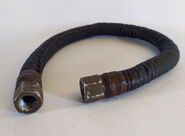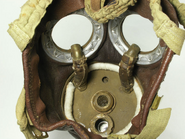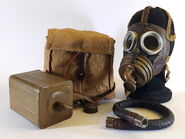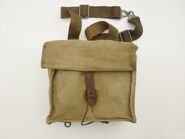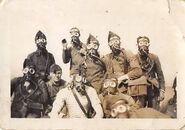This article is about the Belgian respirator. For the American respirator, see M24.
The M.24 (Modèle 24 in French) was a Belgian military mask produced by Pirelli. It supplemented the stocks of ARS and Belgian ARS masks. Between the M.24 and M.24-27 120.000 kits were produced.
Mask overview[]
The faceblank is made from a sheet of tanned leather sewn at the bottom and folded around the outline to create a peripheral seal, underneath which there's a layer of fabric that is used as a base for staps' stitchings. Under the top part of the peripheral seal, the fabric has a rectangular cloth pad to absorb moisture. The mask can have a size marking on the bottom-right of the faceblank; it comes in 3 sizes, G.T. (Grande Taille, Large), T.O (Taille Ordinaire, Normal) and P.T. (Petit Taille, Small).
The faceblank has the following parts are attached to it:
- A seven-points head-harness, with a quick-detach hook on the right side, a special leather support strap connecting to the assembly and a neck strap
- An inlet-outlet assembly at the front
- Two eyepieces
The harness mirrors the ones used in previous Belgian respirators such as the ARS , with the 3 top straps connecting at the top of the head where the leather support strap is attached. The elasticity of each strap is given by two coil springs hidden inside the fabric. The harness is adjustable only at the bottom strap, the one that connects to the brass hook on the side. The leather support strap is fixed on one part to the harness and on the other part to the main assembly; It's adjustable with a brass buckle at the latter end mentioned, and it's kept in place by two leather loops on the top of the mask and halfway through the top strap. The neck strap, which is adjustable, bears the size marking.
The inlet-outlet assembly is made mostly of steel with some brass parts. The size marking is written on the external plate. A circular piece of cloth is wedged between the internal connection between the faceblank and the assembly to absorb moisture. At the top there is a threaded angletube pointing to the left, to which the hose would be attached; this piece leads inside to the two holes to which the Tissot tubes are attached. Under the angletube there is the exhale valve, hidden inside the assembly and protected by two meshes on the inside and outside. The hole at the bottom is closed by a cap at all times and is kept only as a "reserve" (its supposed use is still to be understood, possibly for fortress ventilation).
The eyepieces are made of pressed aluminium and can be unscrewed. The lenses are made up of a single layer of glass, 60mm wide, and they seal with the eyepiece assemblies with each two leather gaskets. Under the innermost leather gasket, there's a steel ring with the topmost part of the Tissot tubes attached.
The Tissot tubes are two totally independent units attached on one end to an eyepiece and on the other to the inlet-outlet assembly. They're composed of a coil spring coated in a thin sheet of leather, secured by one string on each end.
The hose, much like the Tissot tubes, is composed of a long coil spring coated in leather. The leather is kept tightly onto the spring with by being stitched through all its lenght. On each end of the hose, there's a female aluminium thread, sealed to the hose with string waterproofed with a waxy material.
M.24-27[]
Some M.24s were either updated or directly produced in the M.24-27 configuration, but the difference between the two is currently unknown; it's speculated to be the extra perforations on the outside and inside of some inlet-outlet assemblies, which increased airflow to a degree.
Kit[]
Original kit[]
- Facepiece
- Hose
- Filter
- Carrier bag
- Spare lenses
- Box with anti-fogging soap
The carrier was made of water-resistant canvas with some leather parts. There is a rectangular metal piece around the opening on top for keeping the square shape at all times. As of Belgian doctrine, this mask was supposed to be carried on the left side, and it was structured accordingly: it's divided into two parts, one for the hose and mask and the other for the filter. The filter itself is a square box with an angletube facing the front-right of the soldier and an air inlet at the bottom, closed by a 42mm threaded cap, which is secured to the carrier's leather flap with a string, also made of leather. On the divider inside the carrier, there are two compartments covered by a flap with a push button; inside those, there were the spare lenses, protected by a small rag, and a small metal round box with some anti-fogging soap.
Retrofitted kit[]
During the late '30s, some masks were retrofitted with M.29 kits (bag, filter and hose). To do so, one end of the older hose would be torn apart, inserted and sealed into the rubber hose.







